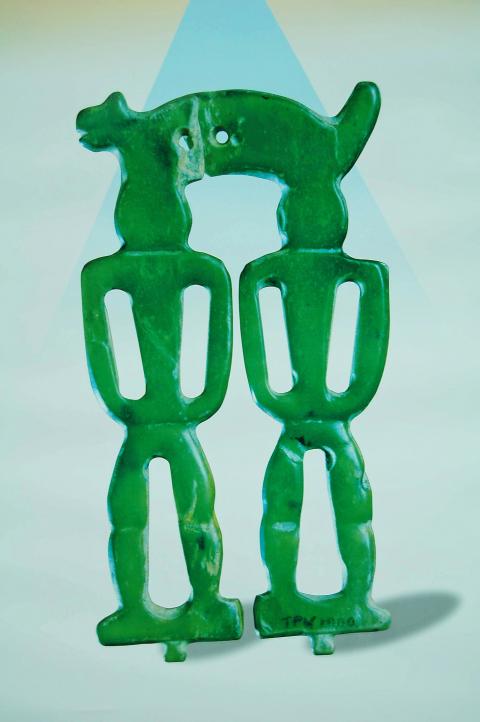David Blundell will give a lecture on Saturday titled “Taiwan roots of the Austronesian Language and Culture,” at the Legislative Yuan, sharing the stage with Democratic Progressive Party (DPP) Legislator Kolas Yotaka, who will discuss the current state of Aboriginal affairs in Taiwan.
Blundell, a professor at National Chengchi University who has been doing anthropological and archaeological research in Taiwan since the early 1980s, will discuss how the majority of Austronesian languages find their origins in Taiwan.
“It’s a history that dates back between 4,500 to 3,500 years,” Blundell told the Taipei Times, when Taiwan’s Aboriginal groups first started to travel to what is today’s Malaysia, Indonesia and the Philippines.

Photo: Huang Ming-tang, Taipei Times
“They weren’t colonists,” Blundell says, “but traders.”
Blundell, who has recently edited Taiwan Since Martial Law: Society, Culture, Politics, Economics and Austronesian Taiwan: Linguistics, History, Ethnology, Prehistory, says that the “Formosans” would trade nephrite jade, grain and pottery to southeast Asia where they would also pass on their languages.
Their languages became incubators for other languages, which Blundell numbers at around 1,200 today, all of which fall under the Austronesian family.
“If the language incubated in Indonesia, it became a different kind of language ... just as European languages became differentiated,” he says, a pattern that repeated itself throughout the region and as far as Madagascar.
Kolas told the Taipei Times through a spokesperson that she will discuss the current land rights issues facing Aborigines.
The lectures will be held at 10am in English at the Legislative Yuan complex, 1 Jinan Rd, Taipei City (台北市濟南路1號). Admission is NT$100 and includes light refreshments.
Attendees must register with Jerome Keating by 10pm tomorrow at: jkeating@ms67.hinet.net.

Most heroes are remembered for the battles they fought. Taiwan’s Black Bat Squadron is remembered for flying into Chinese airspace 838 times between 1953 and 1967, and for the 148 men whose sacrifice bought the intelligence that kept Taiwan secure. Two-thirds of the squadron died carrying out missions most people wouldn’t learn about for another 40 years. The squadron lost 15 aircraft and 148 crew members over those 14 years, making it the deadliest unit in Taiwan’s military history by casualty rate. They flew at night, often at low altitudes, straight into some of the most heavily defended airspace in Asia.

Beijing’s ironic, abusive tantrums aimed at Japan since Japanese Prime Minister Sanae Takaichi publicly stated that a Taiwan contingency would be an existential crisis for Japan, have revealed for all the world to see that the People’s Republic of China (PRC) lusts after Okinawa. We all owe Takaichi a debt of thanks for getting the PRC to make that public. The PRC and its netizens, taking their cue from the Chinese Communist Party (CCP), are presenting Okinawa by mirroring the claims about Taiwan. Official PRC propaganda organs began to wax lyrical about Okinawa’s “unsettled status” beginning last month. A Global

Taiwan’s democracy is at risk. Be very alarmed. This is not a drill. The current constitutional crisis progressed slowly, then suddenly. Political tensions, partisan hostility and emotions are all running high right when cool heads and calm negotiation are most needed. Oxford defines brinkmanship as: “The art or practice of pursuing a dangerous policy to the limits of safety before stopping, especially in politics.” It says the term comes from a quote from a 1956 Cold War interview with then-American Secretary of State John Foster Dulles, when he said: ‘The ability to get to the verge without getting into the war is

Like much in the world today, theater has experienced major disruptions over the six years since COVID-19. The pandemic, the war in Ukraine and social media have created a new normal of geopolitical and information uncertainty, and the performing arts are not immune to these effects. “Ten years ago people wanted to come to the theater to engage with important issues, but now the Internet allows them to engage with those issues powerfully and immediately,” said Faith Tan, programming director of the Esplanade in Singapore, speaking last week in Japan. “One reaction to unpredictability has been a renewed emphasis on